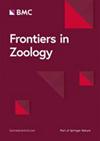The apple of discord: can spider cocoons be equipped with antimicrobial factors?—a systematic review
IF 2.6
2区 生物学
Q1 ZOOLOGY
引用次数: 0
Abstract
The antimicrobial properties of spider silk have been a topic of scientific intrigue since ancient times. Despite extensive research, the question remains unresolved due to conflicting findings and methodological challenges. This work revisits and synthesizes current knowledge, proposing that spider cocoons, rather than other spider products, serve as a particularly promising focus for investigating antimicrobial factors. This emphasis arises from their critical role in parental investment and reproductive success, as the maternal care associated with spider egg sacs suggests the necessity for enhanced antimicrobial protection to safeguard offspring. By investigating existing research, we propose that the protective properties of spider egg sacs may derive not only from the silk itself, but also from the eggs contained within, as supported by previous hypotheses. Furthermore, drawing on the body of knowledge, we suggest that potential antimicrobial defense mechanisms may extend beyond intrinsic factors, encompassing interactions with microorganisms, plants, and other possible environmental elements that remain unexplored but may likely be interconnected. This review highlights that the potential interplay of these factors may be complex and possibly influenced by ecological and biological contexts. Unraveling these dynamics requires an interdisciplinary approach, incorporating diverse methodologies and perspectives to address the gaps in current knowledge. By refining the focus and embracing a broader conceptual framework, future research can provide definitive insights into the antimicrobial properties of spider cocoons. Resolving this long-standing question will not only clarify the scientific debate but also deepen our understanding of spider biology and the adaptive strategies that have evolved to ensure reproductive success.不和谐的苹果:蜘蛛茧能配备抗菌因子吗?-系统评价
自古以来,蜘蛛丝的抗菌性能一直是科学界的一个话题。尽管进行了广泛的研究,但由于相互矛盾的发现和方法上的挑战,这个问题仍未得到解决。这项工作回顾和综合了目前的知识,提出蜘蛛茧,而不是其他蜘蛛产品,作为研究抗菌因子的特别有前途的焦点。这种强调源于它们在亲代投资和繁殖成功中的关键作用,因为与蜘蛛卵囊相关的母性护理表明有必要加强抗菌保护以保护后代。通过对现有研究的调查,我们提出蜘蛛卵囊的保护特性可能不仅来自蛛丝本身,还来自其中的卵,这与之前的假设相一致。此外,根据现有的知识,我们认为潜在的抗菌防御机制可能超出内在因素,包括与微生物、植物和其他可能的环境因素的相互作用,这些因素尚未被探索,但可能相互关联。本综述强调,这些因素的潜在相互作用可能是复杂的,并可能受到生态和生物背景的影响。解开这些动态需要跨学科的方法,结合不同的方法和观点来解决当前知识的差距。通过细化重点和拥抱更广泛的概念框架,未来的研究可以为蜘蛛茧的抗菌特性提供明确的见解。解决这个长期存在的问题不仅将澄清科学争论,而且还将加深我们对蜘蛛生物学和适应策略的理解,这些策略已经进化到确保繁殖成功。
本文章由计算机程序翻译,如有差异,请以英文原文为准。
求助全文
约1分钟内获得全文
求助全文
来源期刊

Frontiers in Zoology
ZOOLOGY-
CiteScore
4.90
自引率
0.00%
发文量
29
审稿时长
>12 weeks
期刊介绍:
Frontiers in Zoology is an open access, peer-reviewed online journal publishing high quality research articles and reviews on all aspects of animal life.
As a biological discipline, zoology has one of the longest histories. Today it occasionally appears as though, due to the rapid expansion of life sciences, zoology has been replaced by more or less independent sub-disciplines amongst which exchange is often sparse. However, the recent advance of molecular methodology into "classical" fields of biology, and the development of theories that can explain phenomena on different levels of organisation, has led to a re-integration of zoological disciplines promoting a broader than usual approach to zoological questions. Zoology has re-emerged as an integrative discipline encompassing the most diverse aspects of animal life, from the level of the gene to the level of the ecosystem.
Frontiers in Zoology is the first open access journal focusing on zoology as a whole. It aims to represent and re-unite the various disciplines that look at animal life from different perspectives and at providing the basis for a comprehensive understanding of zoological phenomena on all levels of analysis. Frontiers in Zoology provides a unique opportunity to publish high quality research and reviews on zoological issues that will be internationally accessible to any reader at no cost.
The journal was initiated and is supported by the Deutsche Zoologische Gesellschaft, one of the largest national zoological societies with more than a century-long tradition in promoting high-level zoological research.
 求助内容:
求助内容: 应助结果提醒方式:
应助结果提醒方式:


